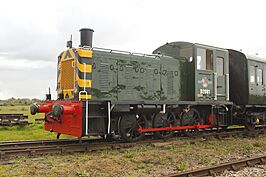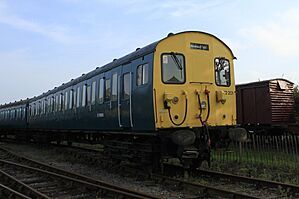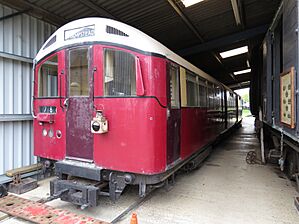Mangapps Railway Museum facts for kids
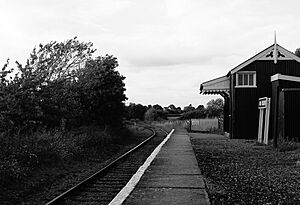
The Old Heath Station building. It was once located at Laxfield on the Mid-Suffolk Light Railway.
|
|
| Lua error in Module:Location_map at line 420: attempt to index field 'wikibase' (a nil value). | |
| Established | 1986 |
|---|---|
| Location | Burnham-on-Crouch, Essex, England |
| Type | Railway museum |
The Mangapps Railway Museum is a special railway center in Essex, England, where you can see and ride on historic trains. It's like a time machine for railways! The museum has a 0.75 miles (1.2 km) long railway track and is run by the Jolly family with the help of many volunteers.
Contents
How the Museum Began
In 1984, the Jolly family moved to Mangapps Farm. The father, John Jolly, was a huge fan of railways and already had a big collection of railway signs, lamps, and other items, known as railwayana.
Soon after moving, he got an old waiting shelter from Brampton station. He set it up in his garden, built a platform, and filled the shelter with his collection. People started visiting and suggested he should open his collection to the public.
John decided to turn his hobby into a real museum. He bought a small diesel shunter engine in 1987. Over the next two years, he added more old railway buildings and tracks, creating the start of a working railway.
In 1989, a steam locomotive named Empress arrived at the farm. That same year, the museum took part in a big event celebrating 100 years of local railway lines. Thousands of people visited over one weekend! This showed the Jolly family that visitors really wanted to ride on the trains. After getting permission from the Railway Inspectorate, they made the track longer. Since Easter 1990, visitors have been able to enjoy train rides at the museum.
The Museum's Collection
The museum has a fantastic collection of trains and railway items, many of which were used in the East Anglia area of England. You can see everything from powerful locomotives to old passenger coaches and goods wagons.
Some interesting items include:
- A pantry car (a coach with a small kitchen) built in 1928.
- A passenger coach from 1956.
- A wooden boxvan for carrying goods, built way back in 1881.
- A special van from France, built in 1932, that could travel on ferries.
- A caboose (a crew car from the end of a freight train) from the Canadian Pacific Railway.
The museum also has a huge number of old signs, badges, and other railway treasures.
Meet the Locomotives
The trains at Mangapps are the stars of the show. Sometimes, they are loaned to other heritage railways, so you might see them at different places around the country.
Steam Locomotives
Steam locomotives are powered by burning coal to heat water into steam.
| Name and Number | Built | Builder | Type | Status | Photograph |
|---|---|---|---|---|---|
| Minnie (No. 358) | 1878 | Fox, Walker and Company | 0-6-0ST (Saddle Tank) | On display for visitors to see. | 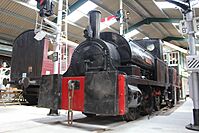 |
| Toto (No. 1619) | 1919 | Andrew Barclay Sons & Co. | 0-4-0ST (Saddle Tank) | Currently being restored to working order. | 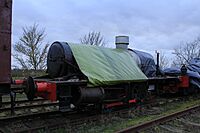 |
| Brookfield (No. 2613) | 1940 | W. G. Bagnall | 0-6-0PT (Pannier Tank) | Working and pulling trains after a major repair completed in 2024. | 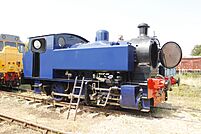 |
| No. 80078 | 1954 | British Rail | Standard Class 4 | Working. It is currently visiting the Mid Norfolk Railway. | 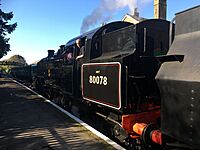 |
Diesel Locomotives
Diesel locomotives use a diesel engine, similar to a large truck, to power the train.
| Number and Name | Class | Built | Status | Notes | Photograph |
|---|---|---|---|---|---|
| 03 018 | Class 03 | 1958 | Undergoing major repairs. | A small shunter engine used for moving wagons. | 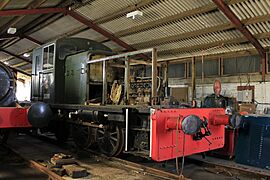 |
| 03 081 Lucie | Class 03 | 1960 | Being repainted into its original green color. | This engine came back to the UK from Belgium in 2004. | |
| 03 089 | Class 03 | 1960 | Working. | You can often see this engine busy at the museum. | 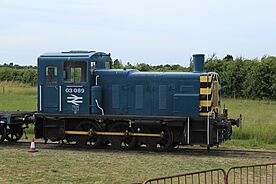 |
| D2325 | Class 04 | 1961 | Working. | This was the very first locomotive to arrive at the museum in 1987! | 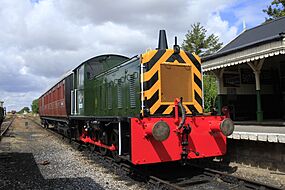 |
| 31 105 "Radio Caroline" | Class 31 | 1959 | Working. | A larger engine for pulling heavier trains. It was named by the musician Rick Wakeman. | 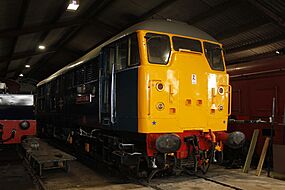 |
| 31 233 | Class 31 | 1960 | Working. | This engine used to work for Network Rail, helping to maintain the main railway lines. |  |
Multiple Units
Multiple units are trains where the engine is built into one or more of the passenger carriages.
Diesel Multiple Units (DMUs)
| Class | Built | Notes | Photograph |
|---|---|---|---|
| Class 117 | 1960 | This is a driving car from a three-car train set that was common across Britain. | 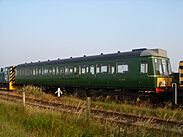 |
Electric Multiple Units (EMUs)
These trains are powered by electricity from an overhead line or a third rail. At Mangapps, they are on display as the line is not electric.
| Class | Built | Notes | Photograph |
|---|---|---|---|
| Class 302 | 1958 | This is a driving trailer car from a train that used to run on lines into London. | |
| 1959 Stock | 1959 | This train car once ran on the London Underground. It was used in the 2017 film Darkest Hour. |
Other Interesting Vehicles
The museum also has smaller, special vehicles used for checking the railway tracks. These are called inspection vehicles or trolleys. One of them is a Canadian Pacific Railway car, and two others are Wickham trolleys that were used on British Rail.
You can also see a service vehicle from the Southend Pier Railway. It was built in 1949 as a passenger car for the pier's narrow railway before being changed to carry tools and equipment.
Image Gallery


